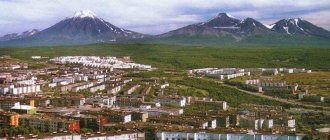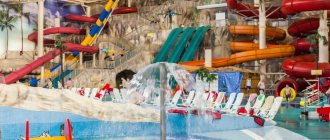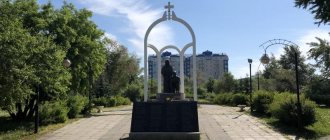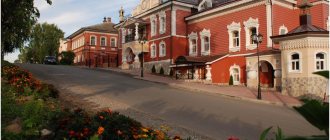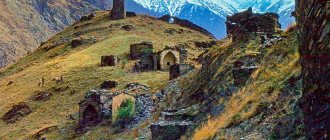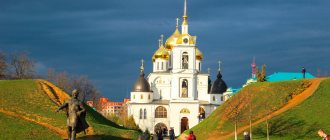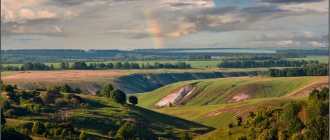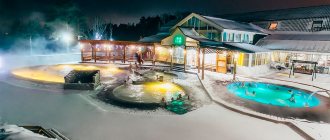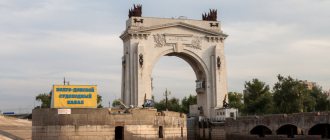Petropavlovsk-Kamchatsky is the largest city in Kamchatka and is interesting for its geographical location.
This city is literally surrounded by volcanoes and geothermal areas. Postcard views of the city from Avacha Bay against the backdrop of the Koryak Hill attract more and more tourists here.
Here you can climb one of the “home” volcanoes closest to the city or visit the Valley of Geysers and look into the caldera of the Uzon volcano with your own eyes. This is compensated by the high cost of the region and the low level of service.
Volcanoes, waterfalls, hills and lakes: where can you go from Petropavlovsk-Kamchatsky?
For ease of route planning, we have marked all the mentioned attractions on the map:
Historical sites and museums
Kamchatka Regional Museum of Local Lore
Address: st. Leninskaya, 20 Phone: Website: www.kamchatka-museum.ru Opening hours: 10:30-18:00 Wed-Sun, Mon-Tue - closed Cost: 120-200 rubles, for children under 18 years old - free
The small museum has a rich ethnographic collection. The educational exhibition will tell you about all the milestones in the history of the region and give an idea of the local natural diversity.
Here you can find out what malachai looks like, what kukhlyanka and pima are, look at a replica of Bering’s skull, take a photo with bears and find out the size of Far Eastern crabs.
Museum of Volcanology and Seismology
Address: Piipa Blvd., 9 Telephone: Website: www.kscnet.ru/ivs/slsecret/muzei/muzej.htm Opening hours: 07:00-20:00 Tue-Fri, Sun; Sat, Mon — day off
The museum is a division of the institute; its collection was collected by several generations of volcanologists. This is the only specialized museum in the Russian Federation dedicated to volcanoes.
The museum presents collections of minerals and rock samples, basalt lava, ash, you can see a collection of photographs of eruptions, and the tour is conducted by real scientists and enthusiasts of their field.
Tours of the museum are strictly by appointment only.
Military Historical Museum of the Kamchatka Flotilla (Exhibition)
Address: st. Radio communications, 69 Phone: Website: https://www.museum.ru/M1491 Opening hours: 10:00-17:00 Mon, Wed-Thu, Sun; 10:00-13:00 Fri, Tue, Sat - day off Cost: adult - 100 rubles, children - 50 rubles, children under 7 years old - free
The center's funds contain samples of military equipment and uniforms, weapons, battle flags and awards, personal belongings and memories of combat veterans.
In the park in front of the museum, examples of Soviet military equipment and Japanese captured equipment are displayed, and a monument to the crew of the L-16 submarine, which sank in the Pacific Ocean during the Second World War, was erected here.
Kamchatka Regional Art Museum
Address: st. Leninskaya, 62 Phone: Website: kamartmuseum.ru Opening hours: 10:00-18:00 daily, seven days a week Cost: 80 rubles.
In addition to the permanent exhibition of fine art, various personal exhibitions and reporting photo exhibitions of local talents alternate in the museum’s halls. With their help, you can see the corners of the edge that are currently inaccessible.
Employees conduct lectures and master classes, during which you can paint a Christmas tree toy or a decorative bottle-vase, or create an animated film. You can also purchase works by local artists here.
Memorial complex of Nikolskaya Hill
Address: st. Krasintsev
The complex consists of several buildings in memory of military exploits. The pentagonal obelisk “Glory” is dedicated to the memory of the soldiers who died during the defense of the port of Petropavlovsk in 1854 from the British and French during the Crimean War. Here, near the mass graves of Russian, English and French soldiers, a stone chapel was erected.
In honor of the centenary and in memory of the “deadly battery” of Lieutenant A. Maksutov, the city’s ship repairers installed several guns of the 1854 model on the hill, which complete the ensemble.
A picturesque panorama of Avacha Bay opens from the hill.
Parks and monuments, streets
Avachinskaya Bay
Coordinates: N 52.97097° E 158.55537° How to get there: for independent boat trips, tourists need to hire transport. You can also explore the bay from the water during an organized excursion.
This bay, also called Avachinskaya Bay, is considered one of the largest ice-free sea bays in the world and the main cargo water gates of Kamchatka, with the largest port of Petropavlovsk-Kamchatsky. The Paratunka and Avacha rivers flow into the bay, and the shores, which are of volcanic origin, are very picturesque. From the water you can clearly see the slopes of the active Avachinskaya Sopka volcano, as well as the dormant Kozelsky Volcano and Koryakskaya Sopka.
In the northern part of the bay in Mokhovaya Bay, right on the old pier of the former cannery, sea lions have set up a rookery. Closer to the exit from the bay there is another interesting place - the small island “Grandma’s Stone”. Its extensive system of underwater grottoes and caves and rich flora and fauna attract diving enthusiasts.
People come to the bay for fishing and crabbing.
Russian Navy vessels are stationed in the bay, so an appropriate permit is required to take a boat trip.
Three Brothers Rocks
Coordinates: 52°53'35″N 158°41'19″E How to get there: you can see the rock from the water during a boat trip. In order to see the rock from land, you need to move from the city along the road to the village of Zavoiko, take the road that leads from Bolshaya Lagernaya Bay to the ocean, and then follow the sign.
Three Brothers is one of the most memorable natural sites of Avacha Bay. An unusual rock formation in the form of three pillars protruding from the water at the entrance to the bay.
According to legend, once upon a time three brothers lived near the bay; they loved each other and their city very much. In those days, the city often suffered from destruction due to high tsunami waves. People did not know how to protect their houses from it, they simply hid in the mountains, waited out the violence of the elements, and then returned and rebuilt their homes. But one day the residents decided to build a barrier that would prevent the wave, and all the townspeople, young and old, tirelessly carried stones and built a high wall. And when their strength ran out and people realized that a new wave was approaching, and they did not have time to complete the dam, panic occurred. Everyone ran, except for the three brothers, who stayed behind and closed the unfinished gap in the wall with their bodies. The dam stood, and the wave receded once and for all. And the brothers’ desire to save their city was so strong that they turned into stones and are still standing guard.
Monument to Peter and Paul
Address: st. Ozernovskaya Spit, 3
The relatively new monument, opened in 2005, is installed in a square on the embankment where locals like to spend time.
The holy apostles Peter and Paul are considered the patrons of the city. On October 17, 1740, the Second Kamchatka Expedition under the command of Vitus Bering entered Avacha Bay on two packet boats. These ships were named after two saints, which is why the city of Petropavlovsk is called that way.
General information about Petropavlovsk-Kamchatsky
Petropavlovsk-Kamchatsky is the capital of the Kamchatka region of Russia. It is located in the far eastern part of the country, on the Kamchatka Peninsula. The city is washed by the waters of Avacha Bay, an area of the Pacific Ocean. The territory of the settlement covers an area of 400 square kilometers, and the number of residents exceeds 180 thousand people. Local time differs from Moscow by +9 hours.
In front of the “face” of Petropavlovsk-Kamchatsky the gentle waves of the Pacific Ocean splash, behind the “back” snow-capped volcanoes rise, and under the “feet” the earth almost constantly trembles - the Kamchatka region is the most seismically active place on the planet
City `s history
The first settlements in Kamchatka appeared in the 17th century, when Russian Cossacks settled here and founded small forts. Active development of the peninsula began after navigator Ivan Elagin, considered the founder of the city, stopped in the bay. Together with his soldiers, he erected small houses on the shore, which became the first buildings in the future city. In 1740, the Second Kamchatka Expedition led by Vitus Bering arrived here. At this time, the settlement acquired its first name - Peter and Paul fort, given in honor of the ships on which the expedition arrived: “St. Peter” and “St. Paul”. However, the settlement did not develop; the state had little interest in the Far East. Petropavlovsk was noticed only at the moment when French and English forwarders began to study the territory of the peninsula, and in 1812 the settlement received the status of a city and a new name - Petropavlovskaya Harbor. In the middle of the 19th century, the Kamchatka region was formed, and the port of Petropavlovsk became the capital. During this period, the city began to actively increase its population. At the beginning of the twentieth century, there was a surge in economic activity in the region, the construction of factories, the necessary infrastructure and the construction of roads began. In the 60s, rapid development of the city began, and therefore the population increased. Today Petropavlovsk-Kamchatsky is the location of the Pacific Fleet of the Russian Federation, as well as a major tourist center of the country, which is visited annually by thousands of travelers from all over the world.
Entertainment
Vulcanarium
Address: st. Klyuchevskaya, 34 Phone: Website: vulcanarium.com Opening hours: 10:00-20:00 Mon-Sun Cost: vulcanarium - 800 rubles, children (5-16 years old) 500 rubles; interestarium - 450 rubles, children's 350 rubles.
A private popular science visitor center introduces visitors to the volcanoes of Kamchatka in an entertaining way. You can touch many exhibits or examine them through a microscope, conduct experiments, pick up a volcanic bomb, sit in a volcanologists’ tent, or float a stone through the water.
Current models clearly demonstrate the life stages of volcanoes, such as eruption. After the tour in the volcanarium building, you can have a snack in the cafe.
Small Valley of Geysers
Book a one-day excursion to the Small Valley of Geysers. The journey will last 12 hours and is suitable for families with children or groups of friends. Payment - 22,000 rubles for a group of up to 5 passengers.
An unforgettable trip to the Small Valley of Geysers awaits you.
The trip will begin at 8:30 am. You will pass the Vilyuchinsky Pass, get acquainted with the northern nature and climb to the observation platforms of Kamchatka. At any time of the year, you can swim in hot springs and take many spectacular photos at the majestic waterfalls.
After a long journey, travelers are entitled to rest and a good dinner. The guide is ready to tailor the program to your wishes and share knowledge about the amazing history of Kamchatka.
Churches and Temples
Holy Trinity Cathedral
Address: st. Vladivostokskaya, 18/4 Telephone: Opening hours: 09:00-18:00, Mon-Sun
The Cathedral of the Holy Life-Giving Trinity is completely new; its construction began only in 2002. A metal capsule containing the Mortgage Deed and the relics of the Holy Vilna Martyrs was laid into the foundation of the temple.
The two-story building, 42 meters high and with a capacity of 3 thousand people, is unique in that it can withstand even a 10-magnitude earthquake.
The mineral paints used for the interior painting of the cathedral will petrify over time, which will allow them to be preserved for centuries. It is planned that in the future the premises of the lower temple will become a concert hall due to good acoustics.
Church of St. Nicholas the Wonderworker
Address: st. Vladivostokskaya, 18 Phone: Website: pravkamchatka.ru/duxovno-prosvetitelskij-centr Opening hours: 09:00-18:00 Mon-Sun
The Spiritual and Educational Center, to which the temple belongs, also has an assembly hall, a school of bell ringers and catechesis, a youth cafe, a children's theater and a library. It is curious that the building where the temple is located today used to house the Rodina cinema.
Today, this particular church is considered the spiritual Orthodox center of the entire region; relics and shrines are brought here, and the largest services are held here.
Attractions in the surrounding area
Kronotsky Reserve
Coordinates: 62.866076, 165.841874 Address: Elizovo district, from Semyachiksky estuary to the mouth of Malaya Chazhma Management address: Elizovo, st. Ryabikova, 48 Phone: Website: kronoki.ru
The area of the reserve is huge and equals 964 thousand hectares. These territories were considered sacred by the local population - the Kamchadals.
According to legend, anyone who dared to encroach on these sacred forests died a terrible death. Thus, this area can be considered the first Kamchatka natural reserve.
Thanks to this, the local flora and fauna were completely unaffected by human actions.
The uniqueness of the flora lies in the fact that scientists are still at a loss as to how the graceful fir (Kamchatka) got here; perhaps these are the only trees that survived the Ice Age.
On the territory of the reserve there are many unique objects: the Death Valley at the foot of the Kikhpinych volcano, the caldera of the extinct giant volcano Uzon, fire-breathing hills and glaciers.
Valley of Geysers
Coordinates: 54.493795, 160.003626 How to get there: the valley is located on the territory of the Kronotsky Biosphere Reserve, access is made either by helicopter or on foot
The Valley of Geysers is considered one of the seven wonders of Russia; it is the only geyser field in Eurasia. This is the canyon of the Geysernaya River, along its banks for several kilometers there are geyser outlets that from time to time throw up a stream of boiling water and steam, mud pots with gurgling liquid of different colors and hot springs, as well as waterfalls and lakes.
The ecosystem of this place is so fragile and unique that the reserve has quotas for access to this region, and the state of nature here is carefully monitored.
The legend says that when gods and volcanoes still lived on earth, mother Kamchatka ruled over everyone, ruling wisely and fairly. But people considered themselves offended because they did not possess immortality, and they began to ask Kamchatka for it. The reasonable mother promised to help only those who are pure in soul. In order to prove their case, each person had to climb into one nostril of a fire-breathing dragon and get out of the other.
Those who dared were washed by Mother Kamchatka with living water, and they lived for a very, very long time. Many years have passed since then, the fire-breathing dragon has turned into stone from old age, and there are almost no brave souls left. The wise mother Kamchatka reliably hid the valley, protected it from the casual eye, and took living water so deep underground that only occasionally it breaks out like a geyser to the surface.
The territory belongs to the reserve and is potentially dangerous for humans, therefore independent visits are strictly prohibited; visits are only possible accompanied by a guide and a reserve employee.
During the nesting period of birds and the mating season of large animals from mid-May to the end of June, access to the valley is partially limited due to the “month of silence”.
Starichkov Island
Coordinates: 52°46′38″N, 158°36′58″E How to get there: the island is located 30 kilometers from Petropavlovsk-Kamchatsky, in the south of Avacha Bay, you can only get here by water transport during an excursion . Visiting time: from June to October
This island, surrounded by reefs, got its name back in the 18th century thanks to the colonies of small birds living on it - old people.
Scientists consider the old people as a single integral ecological system, keep the island under surveillance and even assigned it the status of a nature reserve. The fact is that in addition to the old people, cormorants, guillemots, gulls and other birds also nest on the island - 44 colonies in total.
In addition, seals roost on the rocks, and killer whales feed near Starichkov. An excursion to the island provides an excellent opportunity to observe the fauna of Kamchatka.
If you have not yet chosen where you will live and want to save money when booking, we recommend using the RoomGuru service. Firstly, it contains hotels, apartments and guest houses from many different booking systems, so you won’t miss out on a worthwhile option. Secondly, you can immediately compare prices for one place in different services and book where it is cheaper (this is not always Booking!).
How to get to Petropavlovsk-Kamchatsky
The only way to get to the peninsula is by air. At Yelizovo Airport, which is located thirty kilometers from Petropavlovsk-Kamchatsky, planes from Moscow, Novosibirsk, Khabarovsk and Magadan regularly land.
The airport can be reached by buses No. 102 and 104
There is a daily flight from Moscow:
- Departure time: 17.00;
- Flight duration: about 9 hours;
- ticket price: from 15,000 rubles.
